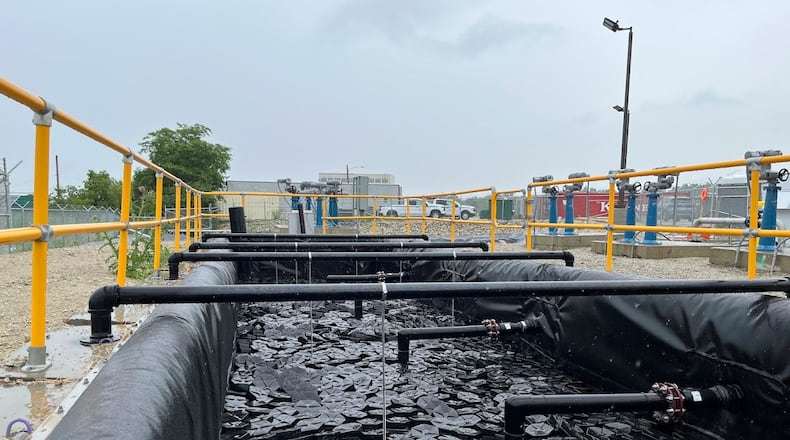Wells and trench systems intercept and filter surface and groundwater flows at dozens of locations across the 8,100-acre base, seeking to capture and filter out PFAS (per- and polyfluoroalkyl) chemicals 365 days a year.
Given the speed at which those involved say the systems have been built in recent years, Wright-Patterson finds itself in an environmental spotlight, serving as a “test case” for other military installations also trying to deal with the chemicals, said Terry Bauer, construction quality control manager for Weston Solutions, who works on the base.
“We have a lot of folks who are interested in coming and looking at this facility,” Bauer said Thursday, standing near a fenced-off collection of basins and monitors on Area A, where seven miles of wiring help monitor and control the flow of water less than 100 feet away from the Mad River. “One of our design engineers has given talks at professional forums about this facility.”
He added, “We expect this is going to be a growth type of industry for quite a while. This is kind of a test case.”
Nearly a year ago, the Air Force said it has spent nearly $59 million to deal with the problem at Wright-Patt.
In all since 2021, some 193 monitoring wells have been built on Wright-Patterson on 16 project sites, collecting more than 400 groundwater samples for testing, engineers said.
Superfund site
The U.S. Environmental Protection Agency informed Wright-Patterson late last year that the base’s migration of PFAS-contaminated groundwater was deemed “not under control,” a change from the base’s previous status.
The update came in a Dec. 16 letter from the Chicago office of the EPA to John Crocker, a remedial project manager at Wright-Patterson.
The notification came after the EPA in 2024 published new “maximum contaminant levels” or “MCLs” for PFAS in drinking water: 4 parts per trillion (ppt) for two of the chemicals, PFOA and PFOS.
For the first time, Wright-Patterson offered local reporters Thursday an on-the-ground look at its ongoing work to clean up the chemicals, a lingering problem that led to a city of Dayton lawsuit against the base and the Department of Defense in 2021.
Much of the problem stemmed from activities that for years no one found objectionable. In 1970, the Air Force began using aqueous film-forming foam to suppress fires, a substance that contained forever chemicals.
On Wright-Patterson, much of that training took place on a section of Area A within sight of the base runway, separated from the Mad River by a line of trees and fewer than 100 feet.
Wright-Patterson no longer uses the foam, the 88th Air Base Wing has said.
Wright-Patt has been considered an EPA Superfund site — a site where long-term federal clean-up efforts are deemed necessary — since the late 1980s, but that designation has had nothing to do with PFAS, said Joseph Ferentz, a remedial program manager at the base.
“I would call them ‘legacy contaminants,’” Ferentz said. “From the landfills, from various spills and releases. We have volatile organic plumes, compound plumes on site.”
Local media were taken to a site on Area B where firefighting foam was accidentally released from a relief valve, within sight of hangars where much of the restoration work takes place for exhibits at the National Museum of the U.S. Air Force.
Here, engineers installed a groundwater capture trench 420 feet long, 30 feet deep and two feet wide to deal with the spill, capturing water in an area characterized by a tight clay silt.
The trench slopes to a submerged pump under a stainless steel box, to a system of basins where water can be filtered and treated.
To date, some 30 million gallons of water have been treated at the site, engineers say, with the system reducing the groundwater concentration levels of PFAS from hundreds to single digits of parts per trillion.
Media were also taken to the Wright Memorial overlooking the Huffman Prairie Flying Field, a stone’s throw from an Area B water treatment system where base officials hope another PFAS system will be built, if federal funds are freed up.
The base also included on the tour a carbon treatment system for drinking water near the Hope Hotel and the headquarters of Air Force Materiel Command on Area A.
Base officials have long said drinking water on and around the base is safe.
“We meet all the EPA regulations for the Safe Drinking Water Act,” said Raymond Baker, environmental branch chief for the 88th Air Base Wing.
About the Author



